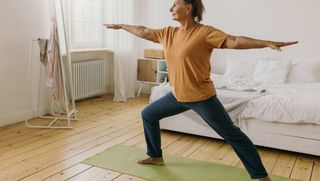Exercising at home: introducing exercise into your home routine
Practical ways to introduce exercise in to your home life.


Summary
Living with low vision doesn’t mean you have to compromise on your fitness goals. In fact, there are a number of ways to incorporate exercise into your daily routine without even leaving the comfort of your own home. Introducing exercise into your home routine not only improves your physical health but also enhances your mental wellbeing and overall quality of life. Here are some ways you can get more active and bring more exercise into your life.
Tips for increasing your physical activity in your daily life
- Start small and simple. Begin by incorporating simple activities into your daily routine, such as taking short walks around your home or neighbourhood.
- Set goals. Setting achievable fitness goals can help you to stay motivated. This could be increasing the duration or intensity of your workouts over time. Your smartphone can help you to track goals, such as by keeping track of steps or time spent standing.
- Walking is an excellent low-impact exercise that can be done indoors or outdoors. You could try walking around your home or around your neighbourhood. Walking can easily be integrated within your everyday routine, too. Try switching out a short bus ride or drive with a longer stroll or make regular plans with a friend to do a local walking trail.
- Everyday housework can be a great way to incorporate physical activity into your daily routine. Whether its sweeping or gardening, household chores can help you to improve your circulation and get you moving.
- Stay consistent. The Australian government recommends that people over the age of 65 do at least 30 minutes of moderate intensity physical activity every day. Even if it’s just a few minutes each day, make it a habit to engage in physical activity regularly. You can then gradually increase the amount of exercise you do over time.
At-home workouts
The Royal National Institution of Blind People (RNIB) have created some home workout videos led by Mr Motivator, which they have kindly shared with us. These short and fun three-minute videos cater to different fitness levels and vision loss, so you can exercise standing up or sitting down. They are also guided by audio and fully accessible. Take a look at the RNIB home workouts playlist so you can enjoy these fun and engaging workout videos from the comfort of your own home.
Three-minute Easy Warmup with Mr Motivator
Warm-up exercises are important to increase your heart rate and circulation which helps you to increase your range of motion. This workout includes shoulder circles, bicep curls, elbow splits, and marching.
Three-minute Stretch Workout with Mr Motivator
Stretching can help to increase your blood flow and improve your flexibility. This workout includes four different arm stretches and can be done standing up or sitting down.
Three-minute Leg Workout with Mr Motivator
Exercise your legs with this three-minute leg workout. This workout includes leg extensions, leg curl, calf raises, and toe raises.
For more information
- Visit RNIB’s home workouts.
- Always speak to your GP and eye care professional about the best treatment options for you.
Did you find this article helpful?
Share your thoughts and help us make our resources better for everyone.
Enjoying the content?
Start building your profile to access personalised support, resources, and tools tailored to your eye health journey.
